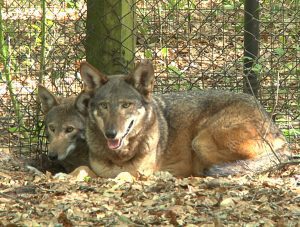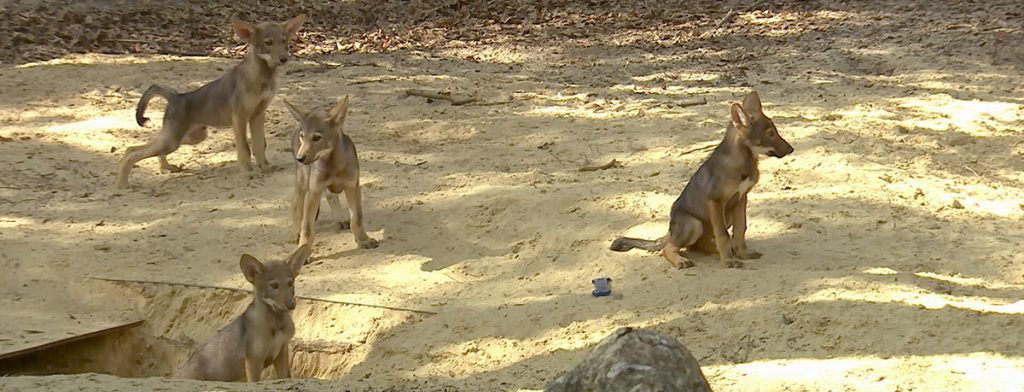We’ll be visiting the Tallahassee Museum every few weeks to see how their four red wolf pups are growing. If you missed it, we had previously visited the Museum when their mother was pregnant with them. We also took a look at the Museum’s role within the overall effort to restore this native predator to the American southeast. We also visited Saint Vincent National Wildlife Refuge, a red wolf island propagation site within the system.
Subscribe to receive more videos and articles about the natural wonders of our area.
Rob Diaz de Villegas WFSU Media
Yesterday, the Tallahassee Museum reopened its red wolf exhibit. Their four new pups are two months old, and they’re still kind of shy. But, if you’re patient, you may get a look at one of them. Last Friday, I took a camera down to get the shots in the video above. After two-and-a-half hours, people stopped coming and little heads topped up from the wolf den. Thirty minutes after that, perhaps they felt better about my presence; they came out and played with their dad for a few minutes (The mom came out for a total of ten seconds during my time there).
“Every one of those animals is so valuable for their genetics,” says Mike Jones, animal curator at the Tallahassee Museum. These aren’t merely cute zoo animals on display for our amusement. They are part of national effort to restore an animal that had once been on the brink of extinction.
The Red Wolf Species Survival Plan
In the video, Mike Jones says that the Tallahassee Museum is proud to participate in the Red Wolf SSP. Species Survival Plans were developed by the Association of Zoos and Aquariums, and are an effort to “maximize population health and diversity.” Currently, there are 22 states where you can find a zoo housing red wolves.
Those zoos coordinate with the US Fish and Wildlife Service on placing red wolves. In addition to the captive population, there are island propagation sites like at Saint Vincent National Wildlife Refuge. And there is also a wild population of over 50 wolves in North Carolina. All of those wolves came from fourteen individuals, the only wild red wolves that the USFWS could find in the 1970s.
“When you start a program with fourteen animals, you have to be very careful when you select the breeding pairs.” Mike says. Using Mean Kinship tests, they determine how related each wolf is to every other wolf. Siblings get a score of zero, and animals below 0 are inbred. The animals with higher scores in relationship to each other are more genetically distinct.
The goal is to pair the most genetically distinct wolves possible, while excluding family lines with genetic defects. Next month, Mike Jones will meet with other members of the Red Wolf SSP to look over the mean kinship tests and determine pairs. This causes a bit of shuffling every year between zoos, island sites, and the North Carolina population.
The Tallahassee Museum’s female wolf arrived in December of 2016 after the current male failed to breed with the previous female. Now they have successfully bred, as have the pair at Saint Vincent Island. But the pups at both sites are destined to travel by the time they reach eighteen months of age.
The Museum Pups at a Glance
- The current litter is made up of three males and one female pup.
- This is the Tallahassee Museum’s fourth litter, and the first in twelve years.
- This is one of five red wolf litters born within the breeding program this year.
- You can currently find the pups in the natural den by the edge of the enclosure. The parents usually stay in the wooden house at the center of the enclosure.
- The pups will reach full size within a year.
- As Mike says in the video, the pups come out when their parents call them. Observing them in the coming months, we’ll see them become more independent.
- The pups will probably not stay at the Tallahassee Museum for more than a year. In fact, they could be gone by December. As Mike said, each pup is a valuable genetic resource, and an important part of the breeding program.
We’ll keep visiting and keeping an eye on the pups as they grow.


